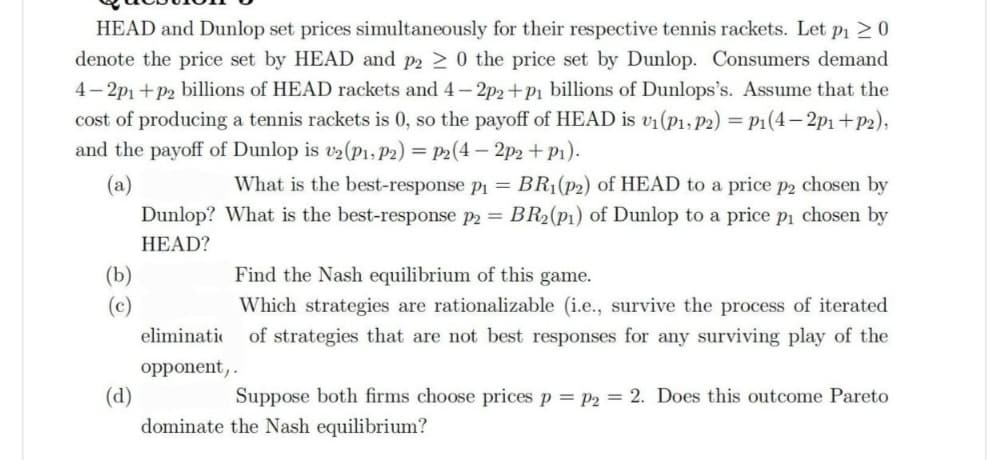HEAD and Dunlop set prices simultaneously for their respective tennis rackets. Let p₁ ≥ 0 denote the price set by HEAD and p2 ≥ 0 the price set by Dunlop. Consumers demand 4-2p1+p₂ billions of HEAD rackets and 4-2p2+p₁ billions of Dunlops's. Assume that the cost of producing a tennis rackets is 0, so the payoff of HEAD is v₁ (P₁, P2) = P1(4—2p₁+P2), and the payoff of Dunlop is v₂ (P1, P2) = P2(4-2p2 +P₁). (a) What is the best-response p₁ = BR₁(p2) of HEAD to a price p2 chosen by What is the best-response p2 = BR₂(p₁) of Dunlop to a price p₁ chosen by Dunlop? HEAD? Find the Nash equilibrium of this game. Which strategies are rationalizable (i.e., survive the process of iterated of strategies that are not best responses for any surviving play of the eliminatio opponent,. (d) Suppose both firms choose prices p = P2 = 2. Does this outcome Pareto dominate the Nash equilibrium? (b) (c)
HEAD and Dunlop set prices simultaneously for their respective tennis rackets. Let p₁ ≥ 0 denote the price set by HEAD and p2 ≥ 0 the price set by Dunlop. Consumers demand 4-2p1+p₂ billions of HEAD rackets and 4-2p2+p₁ billions of Dunlops's. Assume that the cost of producing a tennis rackets is 0, so the payoff of HEAD is v₁ (P₁, P2) = P1(4—2p₁+P2), and the payoff of Dunlop is v₂ (P1, P2) = P2(4-2p2 +P₁). (a) What is the best-response p₁ = BR₁(p2) of HEAD to a price p2 chosen by What is the best-response p2 = BR₂(p₁) of Dunlop to a price p₁ chosen by Dunlop? HEAD? Find the Nash equilibrium of this game. Which strategies are rationalizable (i.e., survive the process of iterated of strategies that are not best responses for any surviving play of the eliminatio opponent,. (d) Suppose both firms choose prices p = P2 = 2. Does this outcome Pareto dominate the Nash equilibrium? (b) (c)
Algebra for College Students
10th Edition
ISBN:9781285195780
Author:Jerome E. Kaufmann, Karen L. Schwitters
Publisher:Jerome E. Kaufmann, Karen L. Schwitters
Chapter12: Algebra Of Matrices
Section12.CR: Review Problem Set
Problem 37CR
Related questions
Question
4th part only

Transcribed Image Text:HEAD and Dunlop set prices simultaneously for their respective tennis rackets. Let p₁ ≥ 0
denote the price set by HEAD and p2 ≥ 0 the price set by Dunlop. Consumers demand
4-2p1+p2 billions of HEAD rackets and 4-2p2+p₁ billions of Dunlops's. Assume that the
cost of producing a tennis rackets is 0, so the payoff of HEAD is v₁ (P₁, P2) = P1(4-2p₁+P2),
and the payoff of Dunlop is v2 (P1, P2) = P2(4-2p2 +P₁).
(a)
What is the best-response p₁ = BR₁(p2) of HEAD to a price p2 chosen by
What is the best-response p2 = . BR₂ (p1) of Dunlop to a price p₁ chosen by
Dunlop?
HEAD?
Find the Nash equilibrium of this game.
Which strategies are rationalizable (i.e., survive the process of iterated
of strategies that are not best responses for any surviving play of the
eliminatio
opponent,.
(d)
Suppose both firms choose prices p = P2 = 2. Does this outcome Pareto
dominate the Nash equilibrium?
(b)
(c)
Expert Solution
This question has been solved!
Explore an expertly crafted, step-by-step solution for a thorough understanding of key concepts.
Step by step
Solved in 4 steps with 2 images

Recommended textbooks for you

Algebra for College Students
Algebra
ISBN:
9781285195780
Author:
Jerome E. Kaufmann, Karen L. Schwitters
Publisher:
Cengage Learning

College Algebra (MindTap Course List)
Algebra
ISBN:
9781305652231
Author:
R. David Gustafson, Jeff Hughes
Publisher:
Cengage Learning

Algebra for College Students
Algebra
ISBN:
9781285195780
Author:
Jerome E. Kaufmann, Karen L. Schwitters
Publisher:
Cengage Learning

College Algebra (MindTap Course List)
Algebra
ISBN:
9781305652231
Author:
R. David Gustafson, Jeff Hughes
Publisher:
Cengage Learning